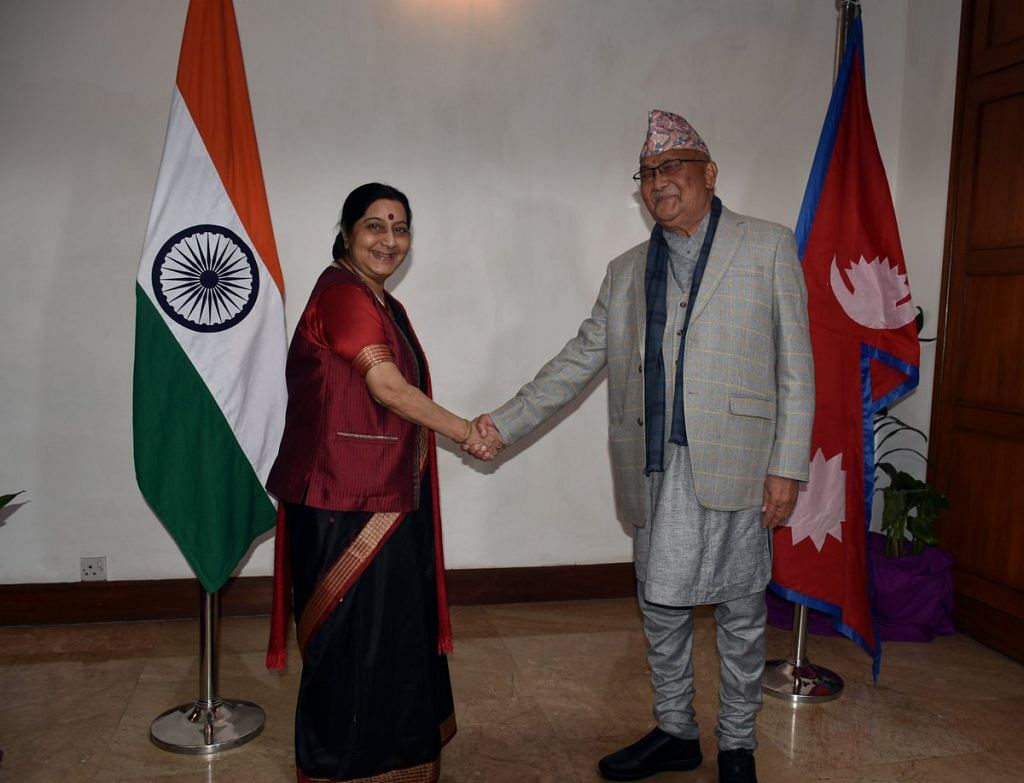India has learnt lessons from the 2015 India-inspired, Madhesi-executed blockade, which backfired.
Prime Minister K.P. Oli, the supreme leader of Nepal, arrives in India 6 April. He heads the government of the Left alliance, which is soon to be christened the Communist Party of Nepal, following the merger of the ‘united Marxist Leninist’ and ‘Maoist centre’ parties.
He is now inarguably the most powerful political leader of Nepal. He will soon enjoy a two-third majority in parliament, a majority in the new upper house, and rule six out of seven provinces. Oli is pro-China and carries a chip on his shoulder about India. A serious goof-up in 2016 about Nepal’s new constitution ignoring its sovereignty and pride has cost New Delhi dear.
After the Dalai Lama was allowed to visit Arunachal Pradesh in 2015, China had declared it would punish India. What followed was full-throated support from the Chinese for the formation of the Left alliance, liberal use of its resources, and the anti-India plank of nationalism, which enabled Oli to sweep the polls. He had earlier won the local government polls.
No prime minister in the brief history of democratic Nepal has amassed such power as Oli, who has armed himself with the ability to implement monumental changes, including the new constitution.
Oli’s aim is to make Nepal stable and prosperous, and “less dependent on India”.
A cursory glance at the map of the Indian subcontinent will show how Nepal occupies the commanding position as its head and crown among the high Himalayas. In a classified exercise done in 1975 at the Army War College, Mhow, called ‘Tribhuvan’, Nepal was regarded as the geo-strategic avenue for any Chinese thrust into the strategic Indo-Gangetic plains bordering UP and Bihar. That pathway is still usable clandestinely by the Chinese, who are adept at this medieval art.
But there are other ways the Chinese are bedding in. Their presence, investment and involvement in Nepal’s domestic politics and creeping interest in the military and police have magnified rapidly. They have already bagged most of the rail, road, hydropower and airport projects. The new Pokhara and Bhairwa (Lumbini) airports and the expansion of the existing Tribhuvan International Airport are all underway with the help of Chinese companies, financed by loans given by Exim Bank.
China has built a new $350 million armed police force academy. The 800-MW Budhi Gandaki hydel project will also be restored to China. The Chinese are investing heavily in the Pokhara lakeside area. About 35 to 40 ‘Confucian centres’ have come up in Terai.
Chinese tourists arriving by air are second only to those coming from India. The Belt and Road Initiative blueprint is at an advanced stage.
But some Nepalese are worried about a Sri Lanka-like debt trap. No one understands how Chinese invest and construct their projects. There is never any criticism of China in Nepal — which is reserved for India — even if fraud is involved. Meanwhile, China has hailed Nepal’s independent foreign policy, criticised India for making Nepal overly reliant on itself, and hoped that all three countries can work together for common development.
No major domestic political change has ever taken place in Nepal without India’s handiwork — from the reconciliation between the Ranas, monarchy and Nepali Congress, to the restoration of multi-party democracy, and the dismantling of the monarchy and the democratisation of the revolutionary Maoists. A pro-China government vanquishing the democratic alliance of the pro-India Nepali Congress was a jolt for New Delhi. They should have known it was coming.
In the past, Nepalese prime ministers, on being anointed, have bent over backwards to be invited to the Delhi durbar, making it their first port of call before Beijing. This used to be done to maintain Nepal’s stated policy of equidistance counselled by the founding father, Prithvi Narayan Shah. This time around, the boot was on the other foot. India had to do some quick and nimble diplomacy — dispatching foreign minister Sushma Swaraj to invite Oli — in making India the first country for Oli visits after becoming prime minister.
In addition, three phone calls from Prime Minister Narendra Modi, who in 2014 became a rock star in Nepal, completed the trick.
India knows it cannot match deep-pocketed China with economic doles. But it has other assets that Beijing cannot emulate, such as geography, open borders, Nepalese soldiers in the Indian Army, a pro-India constituency of ex-servicemen, religion, culture and so on. India has learnt lessons from the 2015 India-inspired, Madhesi-executed blockade, which backfired. Today, the Nepalese want respect from India as they covet their sovereignty.
The days of taking Nepal for granted are gone. A brand new political landscape, sketched by a new generation of leaders of the new Nepal, cannot be dealt with through a 20th-century foreign policy toolbox including roti-beti ka rishta.
India’s strategic diminution is transitory as it has an array of assets to win back the confidence of the Nepalese people. Political engagement at the highest level and focus on geo-economics should be India’s priorities. For the first time, it is advantage Beijing — but that can and must change.
From the Gorkha regiment, Gen. Ashok K. Mehta has explored Nepal since 1959, walking nearly 50,000 km over the years. He has also been involved in track-I and II diplomacy with Nepal.
